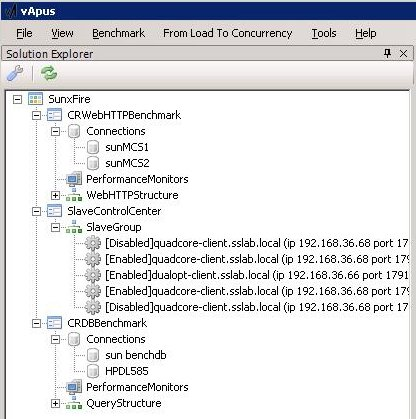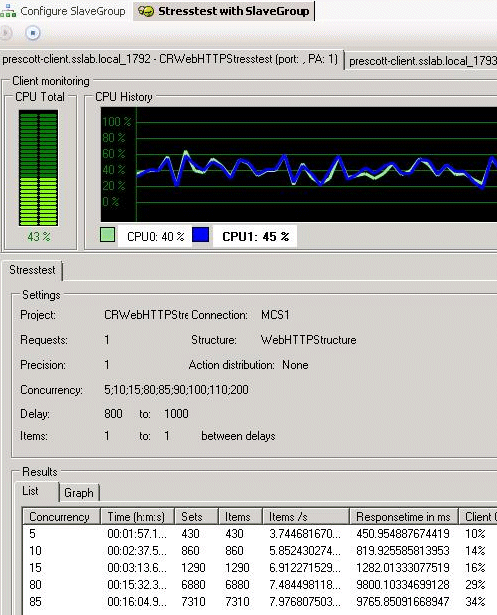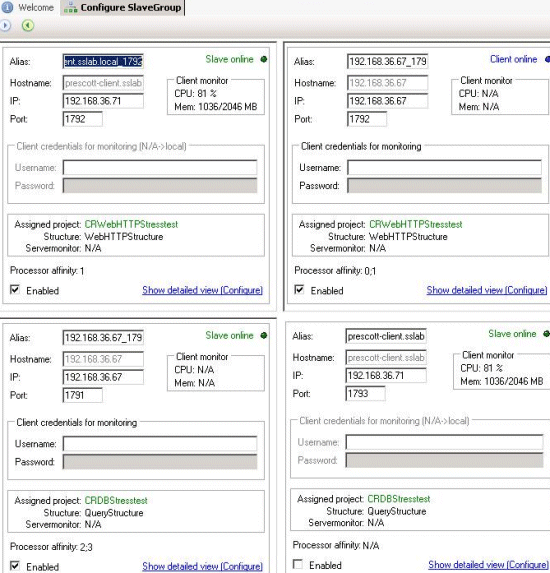Real-world virtualization benchmarking: the best server CPUs compared
by Johan De Gelas on May 21, 2009 3:00 AM EST- Posted in
- IT Computing
vApus: Virtual Stress Testing
Testing uses real-world databases and websites. To make this as realistic as possible we use vApus. vApus or Virtual Application Unique Stresstest is a stress test developed by Dieter Vandroemme, lead developer of the Sizing Server Lab at the University College of West-Flanders. The basic setup works as follows. Each application is logged during business use in the peak hours. These logs are analyzed by the vApus application and queries/URLs requested are grouped into user actions. vApus will simulate the actual actions that people have done by performing these actions again on the application running on a server in our lab. A well-tuned threading mechanism developed in-house launches one thread per user.
The cool thing is that vApus allows us to perform several completely different stress tests on several servers simultaneously. This is ideal for virtual server testing. Let's discuss this a bit more.

Above you can see the connection to -- in this case -- the Sun XFire 4450 server (which is no longer in our lab). Several performance monitors can be started on each tested server. The CRWebHTTPBenchmark is the first benchmark that will be performed, in our case on virtual servers 2 and 3. The CR means "Continuous Rate": each user will perform an action every second (this is configurable of course). The CRDBBenchmark (the third item under the "SunxFire" connection) is the Continuous Rate benchmark for the Decision Support Database.

Above you see what the results look like, in this case on one of our slowest servers. Concurrency indicates how many users are hitting the website, and Item/s is the throughput. We constantly monitor the client CPU to make sure that the client machine is never the bottleneck.
The vApus "master" process launches several separate processes called "slaves", which will stress test a separate server or VM. In our case, there are three slaves: two web tests and one database test will all run in parallel. As vApus must be cheap to use, we wanted to avoid situations where you need a massive battery of clients. Besides the fact that every Slave has an extremely tuned threading system to simulate users, each Slave can have affinity set to one or more CPU(s) of the client PC it runs on. For this test, we used two client machines: a quad-core Core 2 Quad Q6600 at 2.4GHz and our old dual Opteron 2.6GHz test system.

As you can see above, we carefully monitor CPU usage so that we are sure that our clients are never the bottleneck. The beauty of this system is that we were able to simulate between…
- 600-800 Database users on VM1
- Two times 80-110 web users on VM2 and VM3
…while running only two clients. Our quad-core client should have been sufficient, but we wanted to play it safe and give each slave at least two CPUs. The two clients and one master are directly connected via a gigabit switch to the test servers.










66 Comments
View All Comments
Bandoleer - Thursday, May 21, 2009 - link
I have been running Vmware Virtual Infrastructure for 2 years now. While this article can be useful for someone looking for hardware upgrades or scaling of a virtual system, CPU and memory are hardly the bottlenecks in the real world. I'm sure there are some organizations that want to run 100+ vm's on "one" physical machine with 2 physical processors, but what are they really running????The fact is, if you want VM flexability, you need central storage of all your VMDK's that are accessible by all hosts. There is where you find your bottlenecks, in the storage arena. FC or iSCSI, where are those benchmarks? Where's the TOE vs QLogic HBA? Considering 2 years ago, there was no QLogic HBA for blade servers, nor does Vmware support TOE.
However, it does appear i'll be able to do my own baseline/benching once vSphere ie VI4 materializes to see if its even worth sticking with vmware or making the move to HyperV which already supports Jumbo, TOE iSCSI with 600% increased iSCSI performance on the exact same hardware.
But it would really be nice to see central storage benchmarks, considering that is the single most expensive investment of a virtual system.
duploxxx - Friday, May 22, 2009 - link
perhaps before you would even consider to move from Vmware to HyperV check first in reality what huge functionality you will loose in stead of some small gains in HyperV.ESX 3.5 does support Jumbo, iscsi offload adapters and no idea how you are going to gain 600% if iscsi is only about 15% slower then FC if you have decent network and dedicated iscsi box?????
Bandoleer - Friday, May 22, 2009 - link
"perhaps before you would even consider to move from Vmware to HyperV check first in reality what huge functionality you will loose in stead of some small gains in HyperV. "what you are calling functionality here are the same features that will not work in ESX4.0 in order to gain direct hardware access for performance.
Bandoleer - Friday, May 22, 2009 - link
The reality is I lost around 500MBps storage throughput when I moved from Direct Attached Storage. Not because of our new central storage, but because of the limitations of the driver-less Linux iSCSI capability or the lack there of. Yes!! in ESX 3.5 vmware added Jumbo frame support as well as flow control support for iSCSI!! It was GREAT, except for the part that you can't run JUMBO frames + flow control, you have to pick one, flow control or JUMBO.I said 2 years ago there was no such thing as iSCSI HBA's for blade servers. And that ESX does not support the TOE feature of Multifunction adapters (because that "functionality" requires a driver).
Functionality you lose by moving to hyperV? In my case, i call them useless features, which are second to performance and functionality.
JohanAnandtech - Friday, May 22, 2009 - link
I fully agree that in many cases the bottleneck is your shared storage. However, the article's title indicated "Server CPU", so it was clear from the start that this article would discuss CPU performance."move to HyperV which already supports Jumbo, TOE iSCSI with 600% increased iSCSI performance on the exact same hardware. "
Can you back that up with a link to somewhere? Because the 600% sounds like an MS Advertisement :-).
Bandoleer - Friday, May 22, 2009 - link
My statement is based on my own experience and findings. I can send you my benchmark comparisons if you wish.I wasn't ranting at the article, its great for what it is, which is what the title represents. I was responding to this part of the article that accidentally came out as a rant because i'm so passionate about virtualization.
"What about ESX 4.0? What about the hypervisors of Xen/Citrix and Microsoft? What will happen once we test with 8 or 12 VMs? The tests are running while I am writing this. We'll be back with more. Until then, we look forward to reading your constructive criticism and feedback.
Sorry, i meant to be more constructive haha...
JohanAnandtech - Sunday, May 24, 2009 - link
"My statement is based on my own experience and findings. I can send you my benchmark comparisons if you wish. "Yes, please do. Very interested in to reading what you found.
"I wasn't ranting at the article, its great for what it is, which is what the title represents. "
Thx. no problem...Just understand that these things takes time and cooperation of the large vendors. And getting the right $5000 storage hardware in lab is much harder than getting a $250 videocard. About 20 times harder :-).
Bandoleer - Sunday, May 24, 2009 - link
I haven't looked recently, but high performance tiered storage was anywhere from $40k - $80k each, just for the iSCSI versions, the FC versions are clearly absurd.solori - Monday, May 25, 2009 - link
Look at ZFS-based storage solutions. ZFS enables hybrid storage pools and an elegant use of SSDs with commodity hardware. You can get it from Sun, Nexenta or by rolling-your-own with OpenSolaris:http://solori.wordpress.com/2009/05/06/add-ssd-to-...">http://solori.wordpress.com/2009/05/06/add-ssd-to-...
pmonti80 - Friday, May 22, 2009 - link
Still it would be interesting to see those central storage benchmarks or at least knowing if you will/won't be doing them for whatever reason.